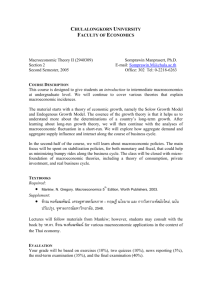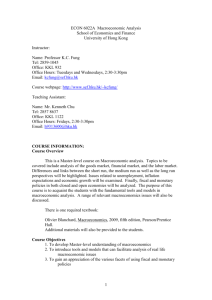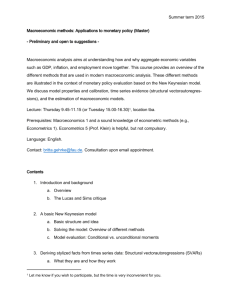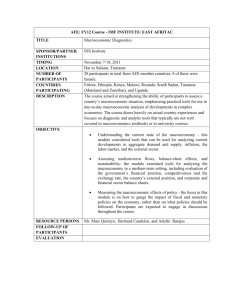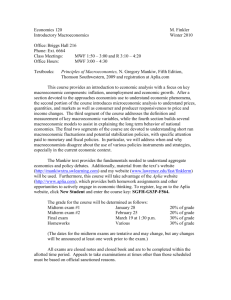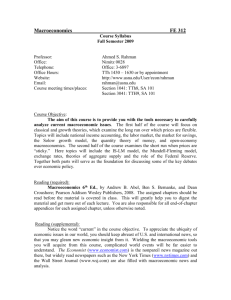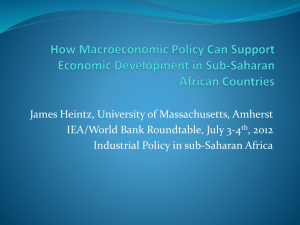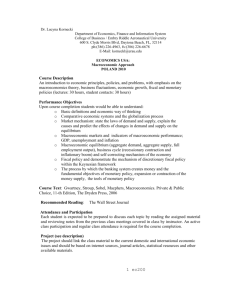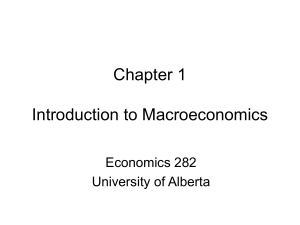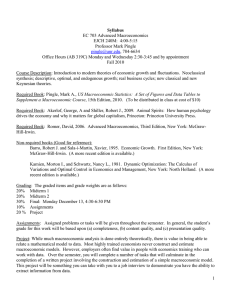- 1 - Intermediate Macroeconomic Theory ECON-E322
advertisement
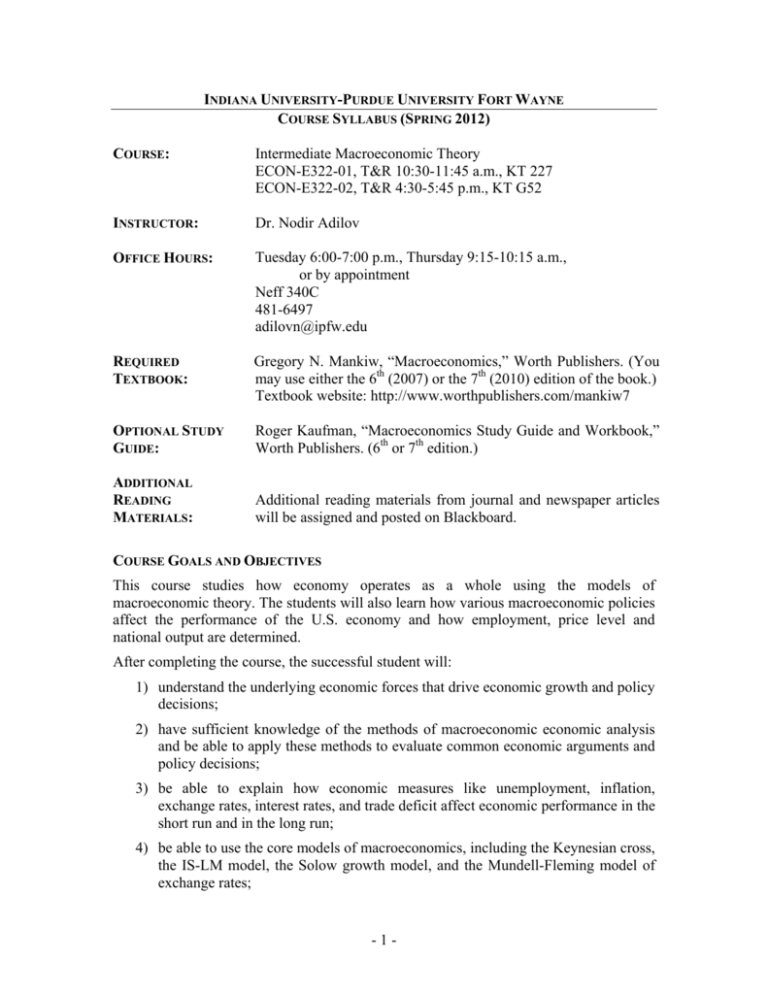
INDIANA UNIVERSITY-PURDUE UNIVERSITY FORT WAYNE COURSE SYLLABUS (SPRING 2012) COURSE: Intermediate Macroeconomic Theory ECON-E322-01, T&R 10:30-11:45 a.m., KT 227 ECON-E322-02, T&R 4:30-5:45 p.m., KT G52 INSTRUCTOR: Dr. Nodir Adilov OFFICE HOURS: Tuesday 6:00-7:00 p.m., Thursday 9:15-10:15 a.m., or by appointment Neff 340C 481-6497 adilovn@ipfw.edu REQUIRED TEXTBOOK: Gregory N. Mankiw, “Macroeconomics,” Worth Publishers. (You may use either the 6th (2007) or the 7th (2010) edition of the book.) Textbook website: http://www.worthpublishers.com/mankiw7 OPTIONAL STUDY GUIDE: Roger Kaufman, “Macroeconomics Study Guide and Workbook,” Worth Publishers. (6th or 7th edition.) ADDITIONAL READING MATERIALS: Additional reading materials from journal and newspaper articles will be assigned and posted on Blackboard. COURSE GOALS AND OBJECTIVES This course studies how economy operates as a whole using the models of macroeconomic theory. The students will also learn how various macroeconomic policies affect the performance of the U.S. economy and how employment, price level and national output are determined. After completing the course, the successful student will: 1) understand the underlying economic forces that drive economic growth and policy decisions; 2) have sufficient knowledge of the methods of macroeconomic economic analysis and be able to apply these methods to evaluate common economic arguments and policy decisions; 3) be able to explain how economic measures like unemployment, inflation, exchange rates, interest rates, and trade deficit affect economic performance in the short run and in the long run; 4) be able to use the core models of macroeconomics, including the Keynesian cross, the IS-LM model, the Solow growth model, and the Mundell-Fleming model of exchange rates; -1- 5) understand the role of money, inflation, and interest rates for monetary and fiscal policy decisions. EXPECTATIONS AND EVALUATION There will be homework assignments, three exams and a paper. I expect that you will attend all classes and actively participate in class discussions. Please do not hesitate to ask questions in class and during my office hours. Remember: there are no bad questions! Learning economics requires practice. Therefore, it is important that you do homework problems as they are assigned. Homework problems will be posted on Blackboard approximately one week before the due date. I will collect about 50% of homework assignments. I will tell you in advance which homework assignments are collected. You are expected to hand in your homework assignments in the beginning of the class on a due date. In case you cannot attend the class, you should make appropriate arrangements to turn in your homework in advance. Your final grade will be determined as follows: Attendance and class participation Homework assignments Paper Exam 1 Exam 2 Final exam 15% 15% 10% 20% 20% 20% The following grading scale will be applied in this course for determination of the final grade: A+ above 99% A 94-98% A90-93% B+ 88-89% B 84-87% B80-83% C+ 78-79% C 74-77% C70-73% D+ 65-69% D 60-64% D55-59% F below 55% If you cannot attend an exam or a class for legitimate reasons, you must notify me in advance. I usually respond to e-mails within 24 hours (except during holidays and weekends). Make-up homework and exams will be given in rare occasions and only when the student is absent due to extraordinary circumstances beyond the student’s control. -2- RESEARCH PAPER For your research paper, you may examine any domestic or international macroeconomic issue. A list of sample topics is attached to this syllabus but I encourage you to develop your own topic. The length of your paper should be around 7 pages (9 pages maximum), and the paper should utilize macroeconomic concepts and tools studied in this course. The timetable for paper submission is as follows: - February 2: submit a paper topic and a half-page abstract that explains the topic of your paper. April 19: completed paper is due. EXTRA CREDIT A student who presents his or her paper in class will receive extra credit. The presentation should be approximately 10 minutes long. Please notify me before April 17 if you would like to present your paper in class. There are no other extra credit opportunities in this class. OTHER POLICIES Students are expected to be familiar with and adhere to the university policies with regard to academic dishonesty. These policies can be found on http://www.ipfw.edu/academics/regulations/honesty.shtml. If you have a disability and need assistance, special arrangements can be made to accommodate most needs. Contact the Director of Services for Students with Disabilities (Walb, room 113, telephone number 481-6658), as soon as possible to work out the details. Once the Director has provided you with a letter attesting to your needs for modification, bring the letter to me. For more information, please visit the web site for SSD at http://www.ipfw.edu/ssd/. NOTE: These policies and course outline are subject to change at the instructor’s discretion. -3- COURSE OUTLINE AND TENTATIVE TIMETABLE FOR COVERAGE OF MATERIAL Chapter 1: The Science of Macroeconomics Chapter 2: The Data of Macroeconomics Economy in the Long Run Chapter 3: National Income: Where It Comes From and Where It Goes (Neoclassical Models of the Economy) Chapter 4: Money and Inflation (The Quantity Theory of Money) February 2: Paper topic and abstract are due Chapter 5: The Open Economy (Foreign Trade, Exchange Rates and Capital Flows) February 16: First Exam (Chapters 1-5) Chapter 6: Unemployment Chapter 7: Economic Growth I: Capital Accumulation and Population Growth (The Solow Growth Model) Economy in the Short Run Chapter 9: Introduction to Economic Fluctuations (Business Cycles and the AD-AS Model) Chapter 10: Aggregate Demand I (Fundamentals of the IS-LM Model) Chapter 11: Aggregate Demand II (Applications of the IS-LM Model) April 5: Second Exam (Chapters 6-11) Chapter 12: The Open Economy Revisited (The Mundell-Fleming Model of Exchange Rates) Chapter 13: Aggregate Supply and the Short-Run Tradeoff Between Inflation and Unemployment (Selective coverage: Phillips Curve) Macroeconomic Policy Debates Chapter 15: Stabilization Policy April 19: Paper is due Chapter 16: Government Debt April 24 - April 26: Student presentations Final Exam: (semi-cumulative): Date to be announced -4- RESEARCH PAPER GUIDELINES A. Topic For your research paper you may examine any domestic or international macroeconomic issue. I encourage you to come up with your own topic. If you have difficulty coming up with a paper topic, you may select it from the list of topics. Try to select a topic that genuinely interests you because you don’t want to be bored writing the paper. B. General Outline Your completed paper should have the following items and sections: Title Author (you) I. Introduction/Significance of the Problem (around 0.5-1 page) This section should explain the significance of the issue you are studying. Why should we (or the government of X) care? II. Analysis (5-6 pages) In this section, you should analyze the issue you are interested in using the tools (models) and concepts learned in E322. Did anyone else study this or similar issue before? What are their main findings? How do your analysis/findings differ from or coincide with the findings of others? Be sure to use data or some other evidence to support your arguments. If you are studying some policy issue, what policy recommendations would you make and why? Make sure that your recommendations and findings are consistent with your evidence. III. Conclusion (0.5-1 page) Summarize your findings. You need to convince the reader that you addressed the issue you wanted to study and that you have important findings/recommendations. Make sure that your conclusions are consistent with your analysis. IV. References Cite your sources in alphabetical order. Use at least five primary sources. Do not forget to cite the sources for your data. When citing references, please use Author(Date) citation style commonly used in economics papers. Sample citation for journal articles: Aigner, D.J., C.A. Lovell and P. Schmidt (1977). “Formulation and Estimation of Stochastic Frontier Production Function Models.” Journal of Econometrics 6(2): 21-38. Sample citation for books: Pindyck, R. (1990). The Structure of World Energy Demand. Cambridge: MIT Press. pp. 36-38. -5- C. Format Your paper should be typed using font 12, double-spaced. The length of your paper should be around 7 pages. Try not to exceed 9 pages. Label, name and number all your graphs and tables. D. Other Suggestions Please feel free to ask questions about any part of your project. If in doubt, use common sense. Do not plagiarize. The university policies with regard to academic dishonesty can be found on http://www.ipfw.edu/academics/regulations/honesty.shtml. You can obtain most US data from the following websites: - the Federal Reserve (research.stlouisfed.org/fred2/) - the Bureau of Economic Analysis (www.bea.gov) - the Bureau of Labor Statistics (www.bls.gov) You can obtain most international data from the following websites: - International Monetary Fund (www.imf.org) - the World Bank (www.worldbank.org) E. Grading The following are the main criteria that will be used to grade your paper: Clarity and Organization (30%) Analysis (50%) Other (20%) Does the student clearly state her/his research question and motivate the topic? Are arguments and conclusions clearly stated? How well does the student communicate her/his ideas? Do paragraphs and sections flow well together? Is the paper well organized? How well does the student understand the topic? Does the student understand the main issues involved? Does the student utilize concepts, models, and analytical techniques studied in the class? Does the student use relevant data in her/his analysis? Are arguments and conclusions supported by the evidence presented? Does the student present her/his own analysis or interpretations? Are all sources properly sited? Does the student use variety of sources? Are tables and figures properly labeled? Are there many spelling or grammar errors? Note: Failure to submit your paper topic or completed paper on time will reduce your paper grade. -6- F. SAMPLE LIST OF PAPER TOPICS 1. Macroeconomic effects of the recent downturn in the housing market. 2. Did recent improvements in worker productivity increase wages? 3. The effects of outsourcing on the U.S. economy. 4. The value of the dollar and performance of the U.S. economy. 5. Did euro improve economic performance in European Union? 6. The effects of recent oil price changes on the U.S. economy. 7. Unemployment and economic growth (Okun’s law). 8. Economic growth and income inequality. 9. Fiscal and monetary policy under liquidity trap. 10. Is the Fed responsible for sub-prime market financial crisis? 11. Do tax cuts help the economy in the long run? 12. Macroeconomic effects of immigration. 13. Short-run and long-run implications of budget deficits. 14. Interest rates and economic growth. 15. Taxes and economic growth. 16. Investment and economic growth. 17. Savings rate and economic growth. 18. Technology and economic growth. 19. Human capital and its effects on the economy. 20. The Iraq War and its macroeconomic implications. 21. Stock market and economic performance. 22. The Phillips curve: The relationship between unemployment and inflation. 23. Should the Fed follow the Taylor rule when targeting interest rates? 24. The role of consumer expectations in economic policy. 25. Gold standard versus the fiat money currency system. 26. Does the U.S. social security system need fixing? 27. The relationship between fiscal and monetary policies. 28. The Great Depression. 29. What causes recessions? 30. Foreign trade, exchange rates, and economic growth. 31. Should credit default swaps be regulated? 32. Housing bubble: causes and prevention. 33. Asset price bubbles and their macroeconomic implications. -7-
